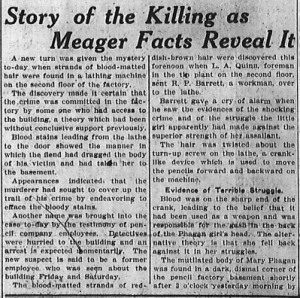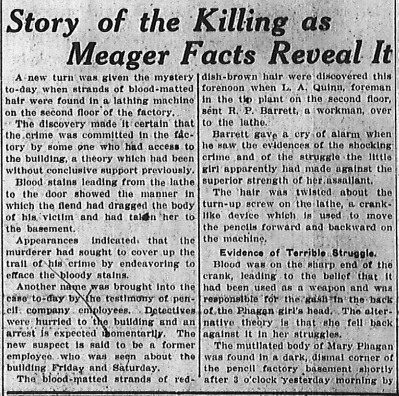 Another in our series of new transcriptions of contemporary articles on the Leo Frank case.
Another in our series of new transcriptions of contemporary articles on the Leo Frank case.
Atlanta Georgian
Monday, April 28th, 1913
A new turn was given the mystery to-day when strands of blood-matted hair were found in a lathing machine on the second floor of the factory.
The discovery made it certain that the crime was committed in the factory by some one who had access to the building, a theory which had been without conclusive support previously.
Blood stains leading from the lathe to the door showed the manner in which the fiend had dragged the body of his victim and had taken her to the basement.
Appearances indicated that the murderer had sought to cover up the trail of his crime by endeavoring to efface the bloody stains.
Another name was brought into the case to-day by the testimony of pencil company employees. Detectives were hurried to the building and an arrest is expected momentarily. The new suspect is said to be a former employee who was seen about the building Friday and Saturday.
The blood-matted strands of reddish-brown hair were discovered this forenoon when L. A. Quinn, foreman in the tip plant on the second floor, sent R. P. Barrett, a workman, over to the lathe.
Barrett gave a cry of alarm when he saw the evidences of the shocking crime and of the struggle the little girl apparently had made against the superior strength of her assailant.
The hair was twisted about the turn-up screw on the lathe, a crank-like device which is used to move the pencils forward and backward on the machine.
Evidence of Terrible Struggle.
Blood was on the sharp end of the crank, leading to the belief that it had been used as a weapon and was responsible for the gash in the back of the Phagan girl’s head. The alternative theory is that she fell back against it in her struggles.
The mutilated body of Mary Phagan was found in a dark, dismal corner of the pencil factory basement shortly after 3 o’clock yesterday morning by Newt Lee, the negro night watchman. The negro said he almost stumbled against the body before he saw it. In the dim, flickering light of the watchman’s lantern the tragedy was revealed in all its ghastliness.
The girlish form lay amid the trash and sweepings of the basement with bruised and bloody face upturned, in a pool of blood, and with the freshly laundered dress of but a few hours before dyed crimson.
All about was the evidence of a terrific struggle. The dilapidated condition of the dead girl’s clothing and the signs of confusion on the dirty basement floor told the tragic story of the girl’s battle for life.
Fought Till She Swooned.
She had fought her brutal murderer until the last—until her strength had given out and she had swooned into death.
The body lay at a point about 75 feet from an elevator shaft. Midway between the body and the shaft, on a pile of trash, was found one of the girl’s shoes—the one from her left foot—and her hat. The slayer had torn the shoe and hat from the little form as the girl struggled vainly to save herself from his blows.
About the girl’s neck was tightly drawn a strong piece of twine. A strip of cloth, torn from her underclothing, was also fastened about her neck. Not satisfied with the blows he had dealt on the head—one blow on the back of the head being so terrific as to discolor one of the girl’s eyes—the slayer had resorted to strangulation to be sure that the last spark of life had been extinguished. A big twine had been drawn so tightly that it was imbedded in the tender flesh, leaving the throat and neck discolored and lacerated.
* * *
Atlanta Georgian, April 28th 1913, “Story of the Killing as the Meager Facts Reveal It,” Leo Frank case newspaper article series (Original PDF)
